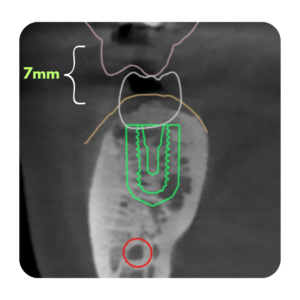I often get asked, “Is it okay to cantilever one tooth off of an implant? How about 2?”
Up until now, my advice has been that it’s okay for small cantilevers such as mandibular incisors, but I wouldn’t recommend it for posterior teeth. But then I came across an article freshly printed in my JOMI by Duygu et al. Let’s see what their experiment shows!
They wanted to find out a couple of things. First, how does zirconia compare to chromium cobalt?
Second, is it better to have one or two implants supporting the cantilevered prosthesis? Here’s what they did:
[mepr-show if=”loggedout”]

Sign Up or login to Implant Ninja Dojo to read the rest of this article.[/mepr-show]
[mepr-show if=”loggedin”]

They placed a stock abutment on the implant, and had a framework made. This framework included the cantilever. Just to be a little more clear about how they set it up, here’s the diagram of the experiment.

Then they proceeded to apply an occlusal force at 30 degrees. This provided a seating force as well as an oblique force.

They found that the arrangements with two implants actually had a higher fracture resistance value than the ones with one implant. So, adding an extra implant can help strengthen the entire thing! This is interesting because in my prosthodontics residency, I learned that this is not necessarily the case for multiple abutments on a natural tooth-borne bridge.

Also, they show that the zirconium frame is weaker than the chromium cobalt frame–no surprise there. As a matter of fact, when the prosthetics with the chromium cobalt framework failed, they failed at parts other than the chromium cobalt frame. The plastic holder actually deformed. Which means, that if it was in a real mouth, adverse forces might not cause damage to the prosthetic but it would still deliver damage to the weakest link–which might be the bone.

Interestingly, BOTH zirc and chromium cobalt still displayed a fracture resistance above the 400 Ncm. This is good news as they remind us that the physiologic limits in the anterior zone are 50-400Ncm.

That means that zirconium would still be a great choice for cantilevers in the anterior zone. When frameworks did break in the one implant scenario, they broke at the distal wall of the abutment.

So, now when someone asks you about cantilevers, you have some solid information to relay back to them! We have solid reason to think that anterior cantilevers with zirconium are A-okay and that you can further improve the whole implant restoration by adding an implant to it. Also, it might not be a bad idea in these situations to use full contour zirconium prosthetics instead of a zirconium frame which is much thinner and therefore weaker.
Hope that helps clear it up![/mepr-show]





Responses